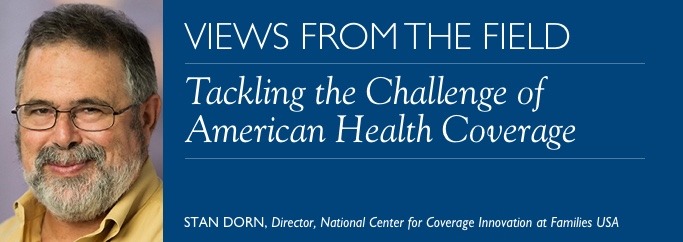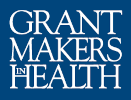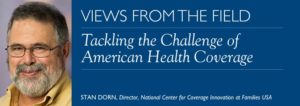
Stan Dorn, Director, National Center for Coverage Innovation, Families USA
A proud history
Foundations deserve tremendous credit for helping millions of families in America obtain basic access to health care.
It started with children. Soon after Senators Hatch (R-UT) and Kennedy (D-MA) passed the Children’s Health Insurance Program in 1997, foundations across America helped policymakers develop and implement innovative strategies to enroll eligible children. This work played a vital role in cutting the number of uninsured children by two-thirds, from 9.9 million in 1997 to 3.3 million in 2015. (U.S. Department of Health and Human Services 2016) Recent research illustrates the importance of this progress, showing how much health coverage increases children’s odds of graduating high school and college, achieving economic self-sufficiency in adulthood, and avoiding serious health problems later in life. (Wherry et al. 2016)
Philanthropy then tackled the challenge of covering adults along with children. Years of foundation-supported studies, consensus-building conversations among opinion leaders, briefings for policymakers and stakeholders, and public education laid the groundwork for the greatest improvement in American health coverage since the enactment of Medicare and Medicaid in the mid-1960s. Thanks to the Affordable Care Act (ACA), approximately 20 million previously uninsured people obtained coverage. The results were extraordinary: fewer race-based disparities in coverage and care, greater financial security for low-income families, improved management of chronic disease, increased receipt of preventive care, and significant declines in death rates for vulnerable populations. (Gruber and Sommers 2019; Blewett, et al. 2018; Adamson, et al. 2019).
Current challenges
Despite this progress, nearly 30 million people still lack health insurance. Half of the uninsured qualify for financial assistance. Remarkably, 61 percent of uninsured children are eligible for Medicaid and CHIP but are not enrolled. People of color, immigrants, adults with serious health problems, low-income people, justice-involved populations, people with mental health and substance use disorders, and very young, low-income children with uninsured parents are particularly likely to lack coverage. (Blumberg, et al., 2018; author’s analysis of American Community Survey data)
In recent days, the U.S. Census Bureau delivered dismaying news: the number of people without health coverage has begun to rise for the first time since the ACA’s main coverage provisions went into effect. (Berchick, et al., 2019) Is this the moment for America’s foundations, once again, to step forward and help our country make significant progress on the fundamentals of health coverage?
Exciting opportunities to make a difference
For funders interested in tackling the foundational issue of health coverage, a rich menu of high-leverage opportunities are ripe for the taking. One important philanthropic role is to help states replicate successful policies implemented elsewhere. This can involve commissioning research, convening stakeholders to develop consensus, supporting public and policymaker education, and funding technical assistance. With such support, states could borrow and extend promising policies like:
- Supplemental affordability assistance. Massachusetts and Vermont are the two states with the highest coverage levels among consumers who qualify for private insurance. (Kaiser Family Foundation 2018). It is no coincidence that these states supplement the federal government in helping low- and moderate-income consumers pay for coverage. Massachusetts structured this assistance to incentivize insurers to lower premiums, yielding the country’s lowest-cost insurance in the individual market (Gasteier, et al., 2018). Other states could follow in their footsteps.
- Tax-based enrollment. Earlier this year, Maryland lawmakers passed, by a broad bipartisan margin, groundbreaking legislation that allows uninsured tax filers to use their tax returns to apply for health coverage. (Dorn 2019) According to Urban Institute research, most uninsured who qualify for help under the ACA file income tax returns. Even among the Medicaid-eligible uninsured, 72 percent of children and 60 percent of people of color file tax returns. (Dorn, et al., 2015) Maryland’s “Easy Enrollment Health Insurance Program” will let them use their tax return information to apply for health coverage. Any state with an income tax could pursue a similar approach, potentially reaching more uninsured than can be found in any other venue.
- Express Lane Eligibility for children, with full auto-enrollment. Express lane eligibility qualifies children for health insurance when another government program has already determined the family to have low income. Two states, Louisiana and South Carolina, automatically enrolled children receiving nutrition assistance into Medicaid, reaching more children in this way than any other state. (Hoag et al. 2013) Additional states could replicate these two pioneer states’ successes.
- Continuous coverage when inmates leave incarceration and return to the community. In states implementing the ACA’s Medicaid expansion, almost everyone leaving jail or prison qualifies for health coverage. However, short insurance gaps between release and the start of Medicaid can have disastrous consequences, with fatal recurrences of substance-use disorders or other serious health problems. States like Arizona have achieved remarkable results by guaranteeing continuous coverage and care, using information-technology solutions and Medicaid policies that other states could potentially borrow. (Wishner and Janetta 2018)
A very different philanthropic role involves shining a light on emerging problems. Between December 2017 and December 2018, the number of people covered by Medicaid fell by 1.6 million, including more than 700,000 children (Ruff and Fishman 2019). States reporting the largest losses had imposed paperwork burdens that made it more difficult for families to remain insured. To address this problem, foundations could commission research that analyzes the causes of enrollment losses and identifies feasible solutions, educating the public as well as state and federal lawmakers.
Conclusion
Unfortunately, our country’s journey broadening the circle of coverage has stalled out and even begun to reverse. Coverage is foundational, required for most other health interventions to succeed. Despite decades of progress, America remains the earth’s only advanced nation that does not guarantee all of its residents the basic access to care promised by health insurance. The philanthropic community can continue to play an important role helping the country make further progress on this fundamental question of social justice.
Sources
Blythe J.S. Adamson, Aaron B. Cohen, Melissa Estevez, Kelly Magee, Erin Williams, Cary Philip Gross, Neal J. Meropol, and Amy J. Davidoff. “Affordable Care Act (ACA) Medicaid expansion impact on racial disparities in time to cancer treatment.” Journal of Clinical Oncology 2019 37:18_suppl, LBA1-LBA1.
Edward R. Berchick, Jessica C. Barnett, and Rachel D. Upton, “Health Insurance Coverage in the United States: 2018,” Current Population Report P60-267 (U.S. Census Bureau, September 2019).
Lynn A. Blewett, Colin Planalp, Giovann Alarcon, “Affordable Care Act Impact in Kentucky: Increasing Access, Reducing Disparities”, American Journal of Public Health 108, no. 7 (July 1, 2018): pp. 924-929.
Linda J. Blumberg, John Holahan, Michael Karpman, and Caroline Elmendorf, Characteristics of the Remaining Uninsured: An Update. Urban Institute. July 2018,
Stan Dorn. Maryland’s Easy Enrollment Health Program. Families USA. March 2019.
Stan Dorn, Matthew Buettgens, and Jay Dev. Tax Preparation Services and ACA Enrollment: Potential Contributions and Challenges. Urban Institute. October 2015.
Audrey Morse Gasteier Emily Brice Marissa Woltmann. “Why Massachusetts Stands Out In Marketplace Premium Affordability.” Health Affairs Blog. September 4, 2018.
Jonathan Gruber and Benjamin D. Sommers. “The Affordable Care Act’s Effects on Patients, Providers and the Economy: What We’ve Learned So Far. National Bureau of Economic Research Working Paper No. 25932. June 2019.
Sheila Hoag, et al. CHIPRA Mandated Evaluation of Express Lane Eligibility: Final Findings, Final Report. Mathematica Policy Research, Urban Institute, Health Management Associates. December 2013.
Kaiser Family Foundation. “Marketplace Enrollment as a Share of the Potential Marketplace Population.” Statehealthfacts.org. 2018.
Emmett Ruff and Eliot Fishman. The Return of Churn: State Paperwork Barriers Caused More Than 1.5 Million Low-Income People to Lose Their Medicaid Coverage in 2018. Families USA 2019.
U.S. Department of Health and Human Services, Centers for Disease Control and Prevention, National Center for Health Statistics. May 2016. Early Release of Selected Estimates Based on Data From the National Health Interview Survey, 2015.
Laura R. Wherry, Genevieve M. Kenney, and Benjamin D. Sommers, “The Role of Public Health Insurance in Reducing Child Poverty,” Acad Pediatr., 16, 3 Suppl (April 2016): S98–S104.
Jane B. Wishner and Jesse Jannetta. Connecting Criminal Justice–Involved People with Medicaid Coverage and Services: Innovative Strategies from Arizona. Urban Institute. March 2018.

